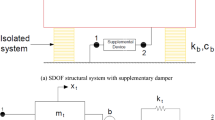Abstract
A novel ground motion selection and modifications method to perform response history analysis of structures is presented in this paper. Currently, the accessibility of ground motion information permits the analysis of structures using real ground motion data. Predicting the dynamic behavior of structures is a primary objective; therefore, the selection of a set of ground motions that shows a reduction in the variability of the structural response and accuracy in preserving the median demand is a challenging task. The new selection and scaling procedure emerges from comparing a set of horizontal ground motions at various ranges of frequency. In this study, the conditional mean spectrum and the design response spectrum are used as target spectra, and the records that give an applicable and compelling contribution to the hazard are considered. It is possible to obtain a set of ground motions with similar seismic severity by matching the target spectrum at the period of interest T ref , where the scaled spectrum should have an equivalent Housner intensity in the period range 0.2T ref –2T ref . The horizontal components for every band of frequency is obtained using a specific index that depends on the energy-frequency trend’s shape as well as on its scattering degree around the mean value. This allows obtaining a set of spectrum-compatible records with almost identical severity and low dispersion of the structural response parameters. The methodology has been tested showing a significant effectiveness in terms of low variability of parameters and accuracy in preserving the median demand for a given hazard scenario.

















Similar content being viewed by others
References
Ambraseys NN, Douglas J, Rinaldis D, Berge-Thierry C, Suhadolc P, Costa G, Sigbjornsson R, Smit P (2004) Dissemination of European strong-motion data, CD-ROM collection, vol 2. Engineering and Physical Sciences Research Council, Swindon
Applied Technology Council (2011) Draft guidelines for seismic performance assessment of buildings, vol 1. Methodology ATC-58-1
Baker JW (2011) Conditional mean spectrum: tool for ground-motion selection. J Struct Eng ASCE 137:322–331
Baker J, Cornell CA (2006) Spectral shape, epsilon and record selection. Earthq Eng Struct Dyn 35:1077–1095
Baker JW, Jayaram N (2008) Correlation of spectral acceleration values from NGA ground motion models. Earthq Spectra 24(1):299–317
Banerjee S, Shinozuka M (2008) Mechanistic quantification of RC bridge damage states under earthquake through fragility analysis. Probab Eng Mech 23(1):12–22
Boore DM, Atkinson GM (2008) Ground-motion prediction equations for the average horizontal component of PGA, PGV, and 5%-damped PSA at spectral periods between 0.01 s and 10.0 s. Earthq Spectra 24(1):99–138
Boulanger RW, Curras CJ, Kutter BL, Wilson DW, Abghari A (1999) Seismic soil–pile-structure interaction experiments and analyses. J Geotech Geo Environ Eng 125(9):750–759
Bradley BA (2010) A generalized conditional intensity measure approach and holistic ground-motion selection. Earthq Eng Struct Dyn 39:1321–1342. doi:10.1002/eqe.995
Cimellaro GP (2013) Correlation in spectral accelerations for earthquakes in Europe. Earthq Eng Struct Dyn 42(4):623–633
Cimellaro GP, Marasco s (2015) A computer-based environment for processing and selection of seismic ground motion records OPENSIGNAL. Front Built Environ 1:17. doi:10.3389/fbuil.2015.00017
Cimellaro GP, Reinhorn AM, D’Ambrisi A, De Stefano M (2011) Fragility analysis and seismic record selection. J Struct Eng ASCE 137(3):379–390
Computer and Infrastructure Inc (2015) Sap2000, Version 17.3, Berkeley, CA
Cornell CA (1968) Engineering seismic. risk analysis. Bull Seismol Soc Am 58(5):1583–1606
EC2 (2002) Design of concrete structures. European Committee for Standardization, Bruxelles
EC8 (2005) Design of structures for earthquake resistance. European Committee for Standardization, Bruxelles
FEMA (2000) FEMA 351: Recommended seismic evaluation and upgrade criteria for existing welded steel moment-frame buildings. FEMA 351 Federal Emergency Management Agency, Federal Emergency Management Agency, Washington, DC
Gerolymos N, Gazetas G (2005) Winkler model for lateral response of rigid caisson foundations in linear soil. Elsevier, Amsterdam, pp 347–361
Iervolino I, Galasso C, Cosenza E (2010) REXEL: computer aided record selection for code-based seismic structural analysis. Bull Earthq Eng 8:339–362
INGV (2014) The National Institute of Geophysics and Vulcanology. http://www.ingv.it/en/
Jamiolkowski M (1968) Atti e rassegna tecnica della società ingegneri e architetti di Torino no 7, 169–172 (in Italian)
Katsanos EI, Sextos AG, Manolis GD (2010) Selection of earthquake ground motion records: a state-of-the-art review from a structural engineering perspective. Soil Dyn Earthq Eng 30:157–169
Lin B, Haselton CB, Baker JW (2013) Conditional-spectrum-based ground motion selection. Part II: Intensity-based assessments and evaluation of alternative target spectra. Earthq Eng Struct Dyn 42(12):1867–1884
Manfredi G (2001) Evaluation of seismic energy demand. Earthq Eng Struct Dyn 30(4):485–499
NTC-08 (2008) Nuove Norme Tecniche per le Costruzioni (NTC08). Consiglio Superiore dei Lavori Pubblici, Ministero delle Infrastrutture, Gazzetta Ufficiale della Repubblica Italiana, n. 29 (in Italian)
Shome N, Cornell CA, Bazzurro P, Carballo JE (1998) Earthquakes, records and nonlinear responses. Earthq Spectra 14(3):469–500
Tso WK, Zhu TJ, Heidebrecht AC (1991) Engineering implication of ground motion A/V ratio. Soil Dyn Earthq Eng 11(1992):133–144
USGS (2013) Seismic hazard analysis tools. U.S. Geological Survey. http://earthquake.usgs.gov/hazards/designmaps/grdmotion.php
Acknowledgements
The research leading to these results has received funding from the European Research Council under the Grant Agreement No ERC_IDEAL RESCUE_637842 of the project IDEAL RESCUE—Integrated Design and Control of Sustainable Communities during Emergencies.
Author information
Authors and Affiliations
Corresponding author
Rights and permissions
About this article
Cite this article
Marasco, S., Cimellaro, G.P. A new energy-based ground motion selection and modification method limiting the dynamic response dispersion and preserving the median demand. Bull Earthquake Eng 16, 561–581 (2018). https://doi.org/10.1007/s10518-017-0232-5
Received:
Accepted:
Published:
Issue Date:
DOI: https://doi.org/10.1007/s10518-017-0232-5




